I visited a first grade last week, and the teacher asked me to take over an already-in-progress Which One Doesn’t Belong? (#wodb) conversation with a small group. She’d chosen this image, shape 2 from Mary Bourassa at wodb.ca.
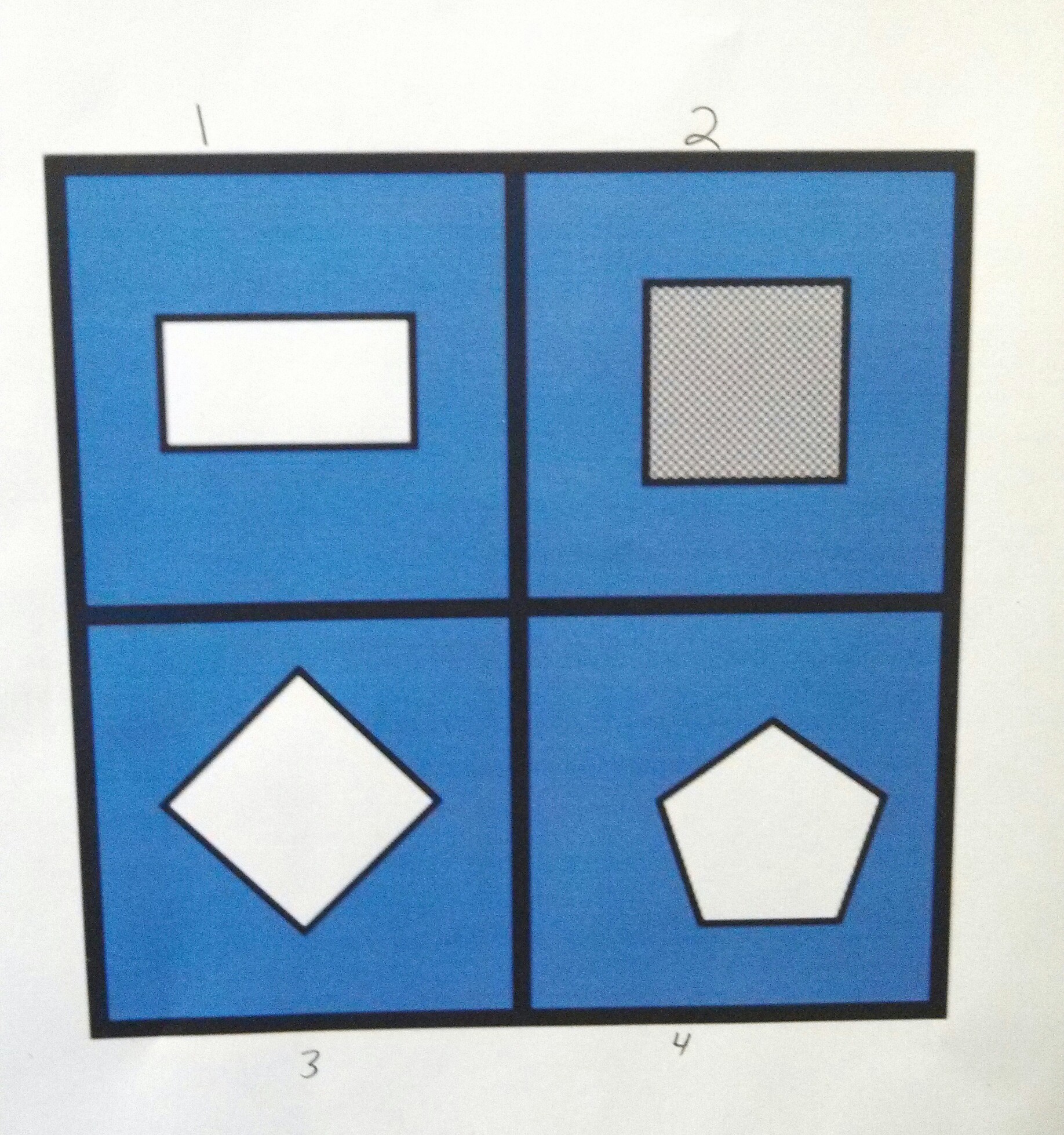
I’d heard the last couple of comments, and noticed kids were referring to these shapes rectangle, square, diamond, and pentagon. I know that children are usually describing shape and orientation when they use the word diamond, so the first thing I did was turn the page 45° to see what would happen.
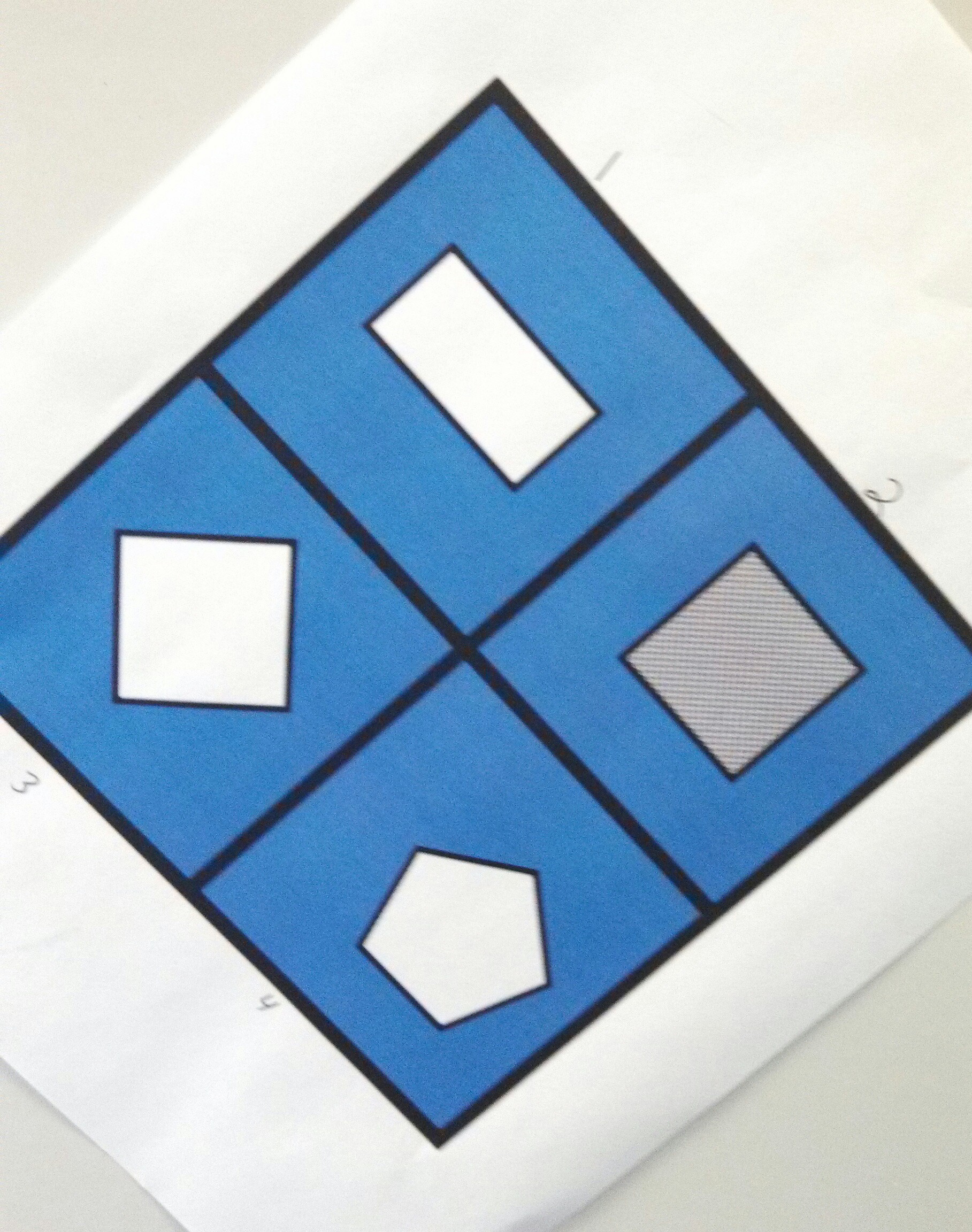
Abby said, “Now you turned the gray one into a diamond and the white one into a square.” The other kids nodded their agreement.
I have learned so much about this moment from Christopher Danielson. In his brilliant book, Which One Doesn’t Belong? A Teacher’s Guide, he digs into the mathematics of diamonds and rhombuses, children’s informal and formal language, and how we might teach in a moment like this. My favorite sentence, which is pinned above my desk at work:
I have come to understand that talking about this difference is more important than defining it away.
Earlier in my career, I would have been tempted to define it away. With Christopher on my shoulder, I engaged the kids in a #diamondchat instead. I drew a quick #wodb with a rhombus, a kite, a diamond-cut gem, and a baseball diamond. I asked, Which of these shapes are diamonds? We played around with the word and I learned a lot about their thinking. Mario looked unsettled and said, “Now I’m not so sure what a diamond is.” He turned to me and asked, “What’s a diamond? Which one is right?”
I said, “I don’t know. It’s up to you.”
The kids gasped.
I smiled and went on, “Diamond is a great word. We can use it to talk to each other so people understand what we mean. But it doesn’t have a strict definition in math, like some other words do. For example, the word ‘square’ has a meaning in mathematics, and we can all agree on that meaning. But diamond isn’t like that. Its meaning is really up to you and what you’re talking about. If you think this is a diamond, it’s a diamond.”
Students liked this idea.
It was time to move on to a new #wodb, so I looked through the ones the teacher had printed out, and went for something different:
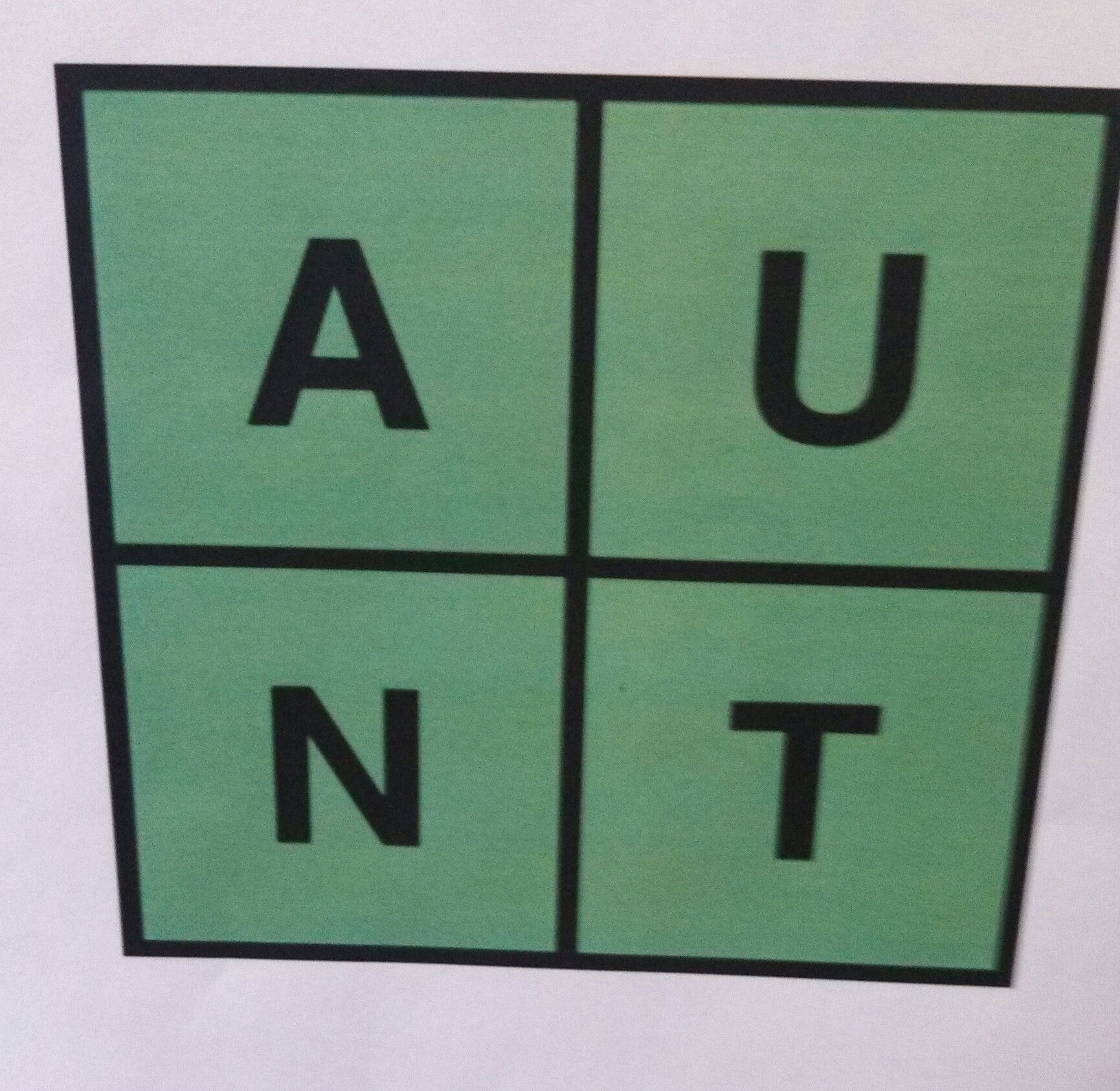
This one is from Cathy Yenca. It produced the desired effect right away:
Rianna: “I thought we were talking about math! Why’d you put this up! There are no letters in math!”
Mario: “Well, I guess you could think about them as shapes. Like U doesn’t belong because it has two lines and then a curvy handle thing at the bottom. And A doesn’t belong because it has an inside space. And T doesn’t belong because it’s the only one made out of 2 straight lines…”
Abby interrupted, “T only has 1 straight line.”
This one caught me off guard. “What do you mean?”
She gestured up-and-down with her hand and said, “That’s a straight line, and then it has a bar across the top.”
I asked, “How many straight lines does the N have?”
Abby: “Two.”
“What about now?”
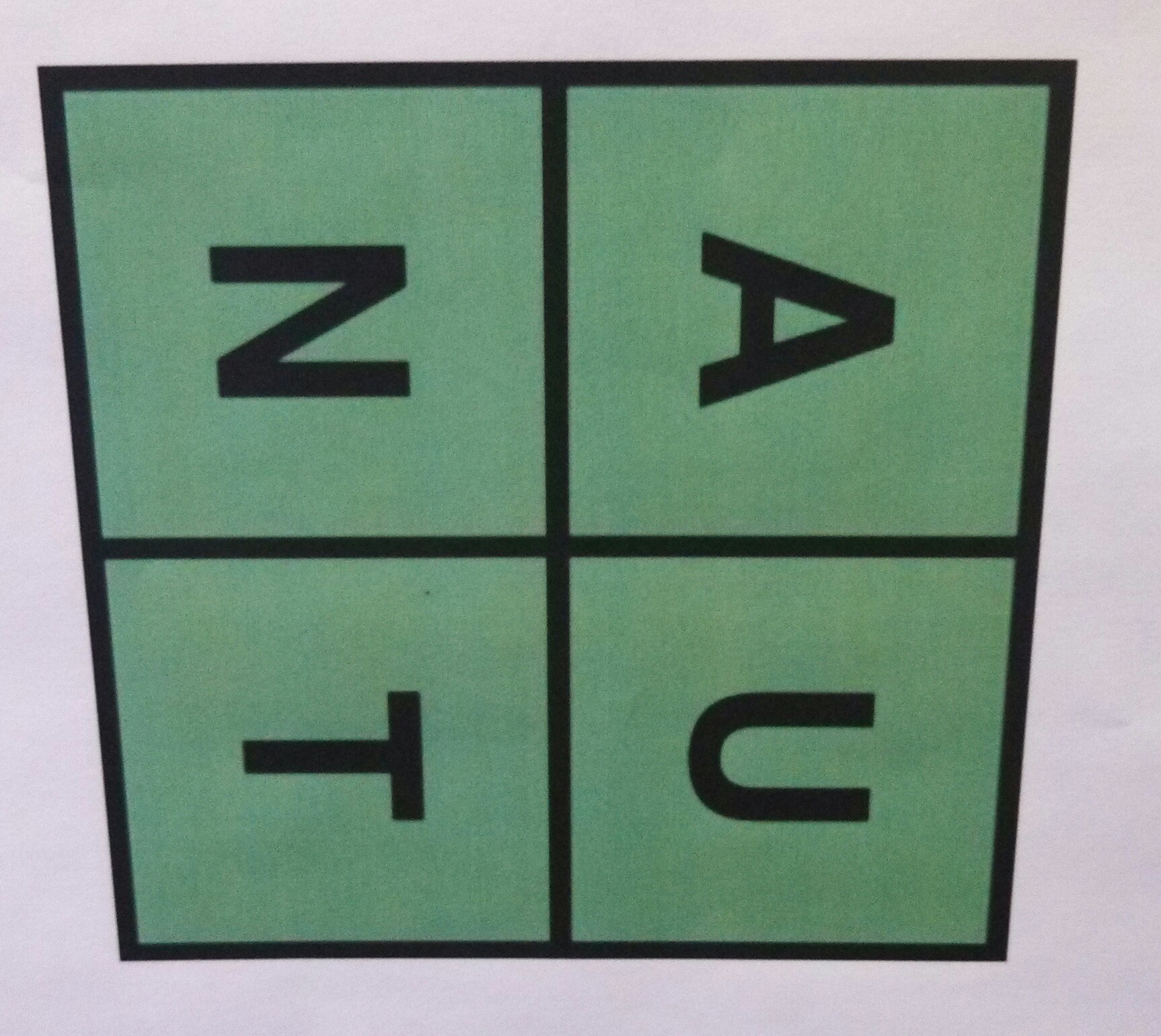
Abby: “Now the N doesn’t have any straight lines.”
“What about the T now that it’s turned?”
“It still has one straight line, but now it’s that one.” She pointed to the now-vertical part of the T.
I pulled out a marker. “Is this a straight line?”

Abby: “It’s pretty close.”
“Right. Pretty close. Pretend I’d made it perfect.”
“Then yeah, it’s a straight line.”
“What about this one?”
“That’s a laying-down line.”
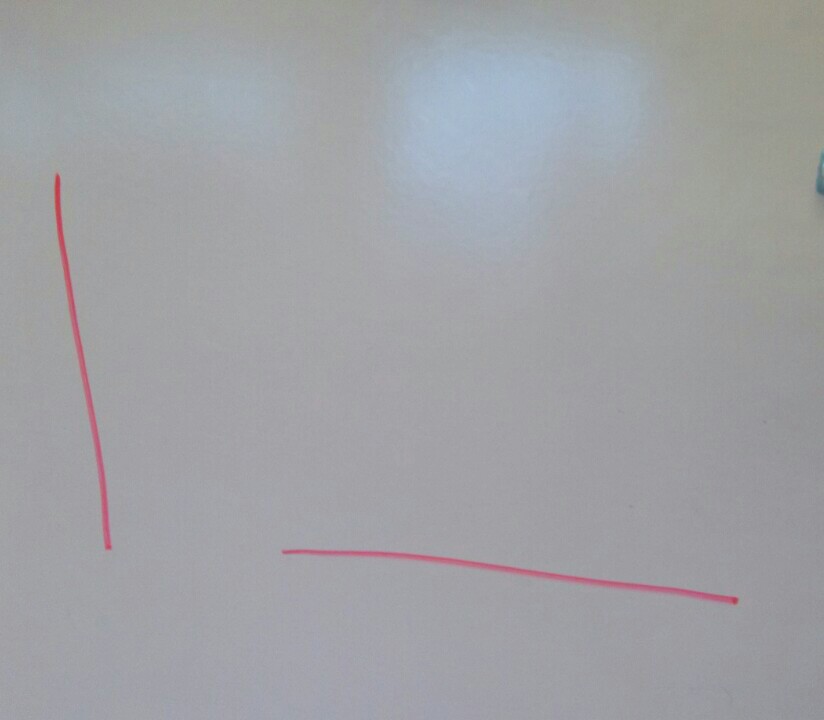
What about this one?
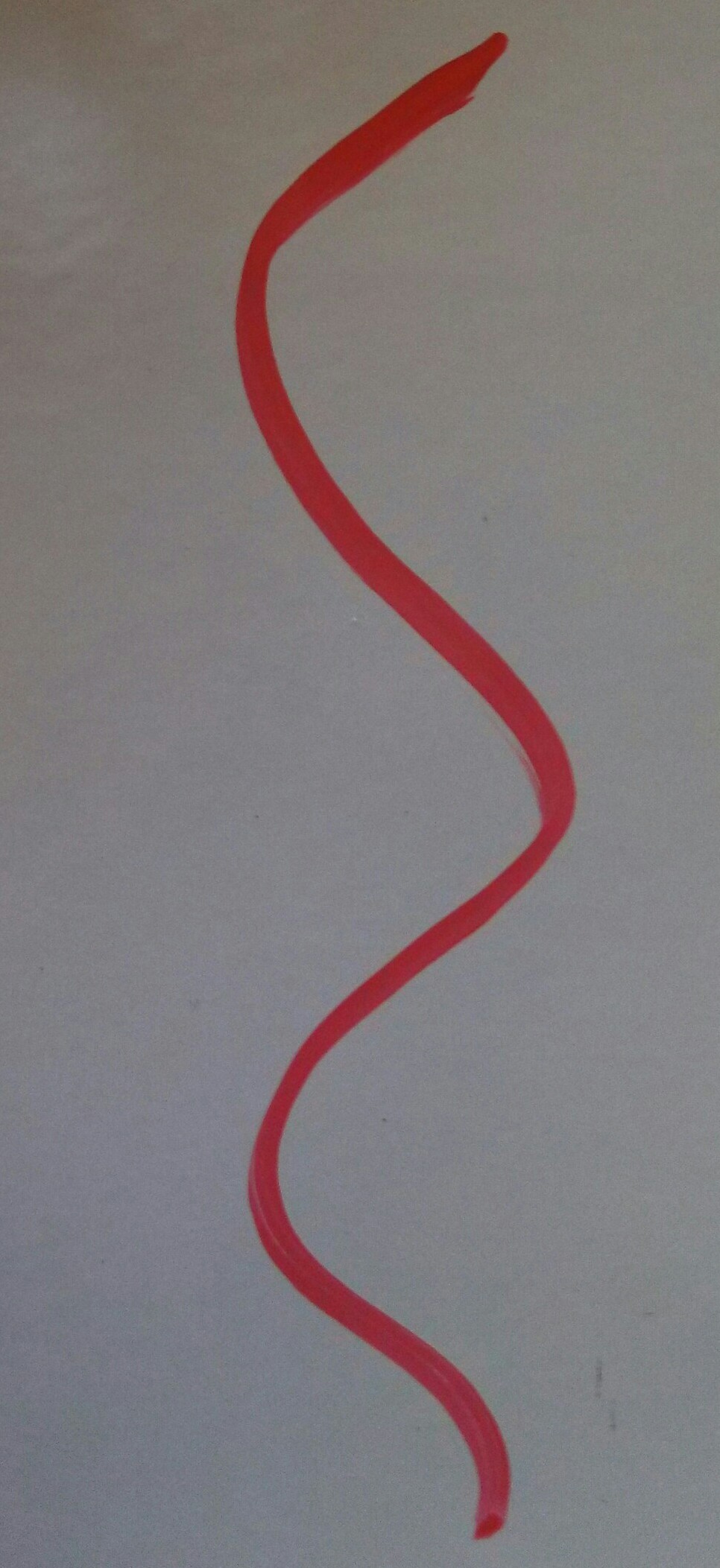
“That’s straight but wiggled.”
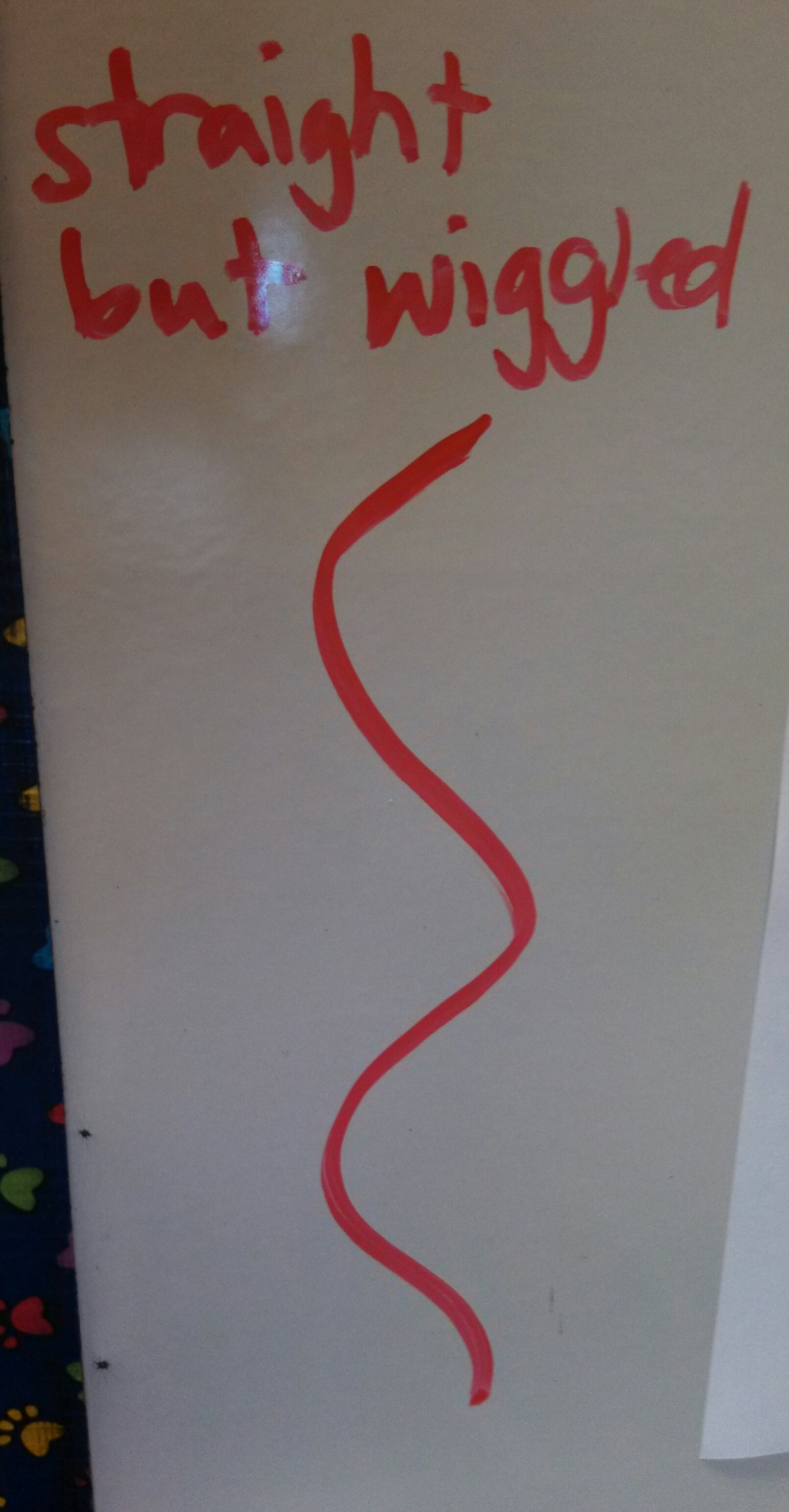
Oh man. How awesome is that?
The kids started arguing, in the best sense of the word.
Willy: “I don’t think that’s straight. Straight means it doesn’t have any wiggles or curves.”
Julie: “No, straight means it goes up and down. It doesn’t matter if it’s curved.”
Those were the clear terms of the debate. So now what do I do? I have Christopher on my shoulder still.
I have come to understand that talking about this difference is more important than defining it away.
I also have the knowledge that defining it away isn’t going to convince Abby or Julie or Mario. They might say “OK” to please the teacher, but I’m not going to change any minds that way.
At the same time, my mind is reeling, wondering how we use this word “straight” informally? Why have kids inferred that straight means up-and-down?
“Kids, line up in a straight line.”
“Sit up straight.”
“That picture is crooked. Can you straighten it?”
“Put the books on the shelf so they’re straight.”
In our everyday language, we sometimes do use “straight” to mean upright or vertical or aligned. I didn’t think of all these examples on the spot, but in the moment, I was confident I would think of them later. In the moment, I knew Abby had a good reason for her argument, based on her lived experience, even if I hadn’t figured it out yet. That faith in her sense-making matters a lot in this interaction. Her understanding of “straight” isn’t wrong; it’s incomplete. My job is to help her layer in nuance and context to her understanding of “straight,” so she knows what it means in an informal sense and what it means in geometry.
With the kids, I told them it might help us communicate if we added a few other words to the mix. I asked if they knew the words vertical or horizontal? They did, Abby included. They were able to correctly match the lines to the word.
Abby said, “I think there should be more words for lines.”
“Like what?”
“Like, vertiwiggle. That would be up-and-down and wiggled. And horizontawiggle for lying-down lines that are wiggly.”
This was the moment to stop pressing. That much I knew.
By coining these new words, Abby had let me know she was now thinking about two different attributes at the same time: the orientation and the wiggliness. I wasn’t about to resolve that complexity or define it away. I wanted her to think about it. I’ll check in with her next time and see what she thinks.
The classroom teacher said her mind was blown by this conversation. She had the whole class join us, and I erased the board. I used a straightedge and drew only the straight, vertical line. The whole class agreed it was straight.
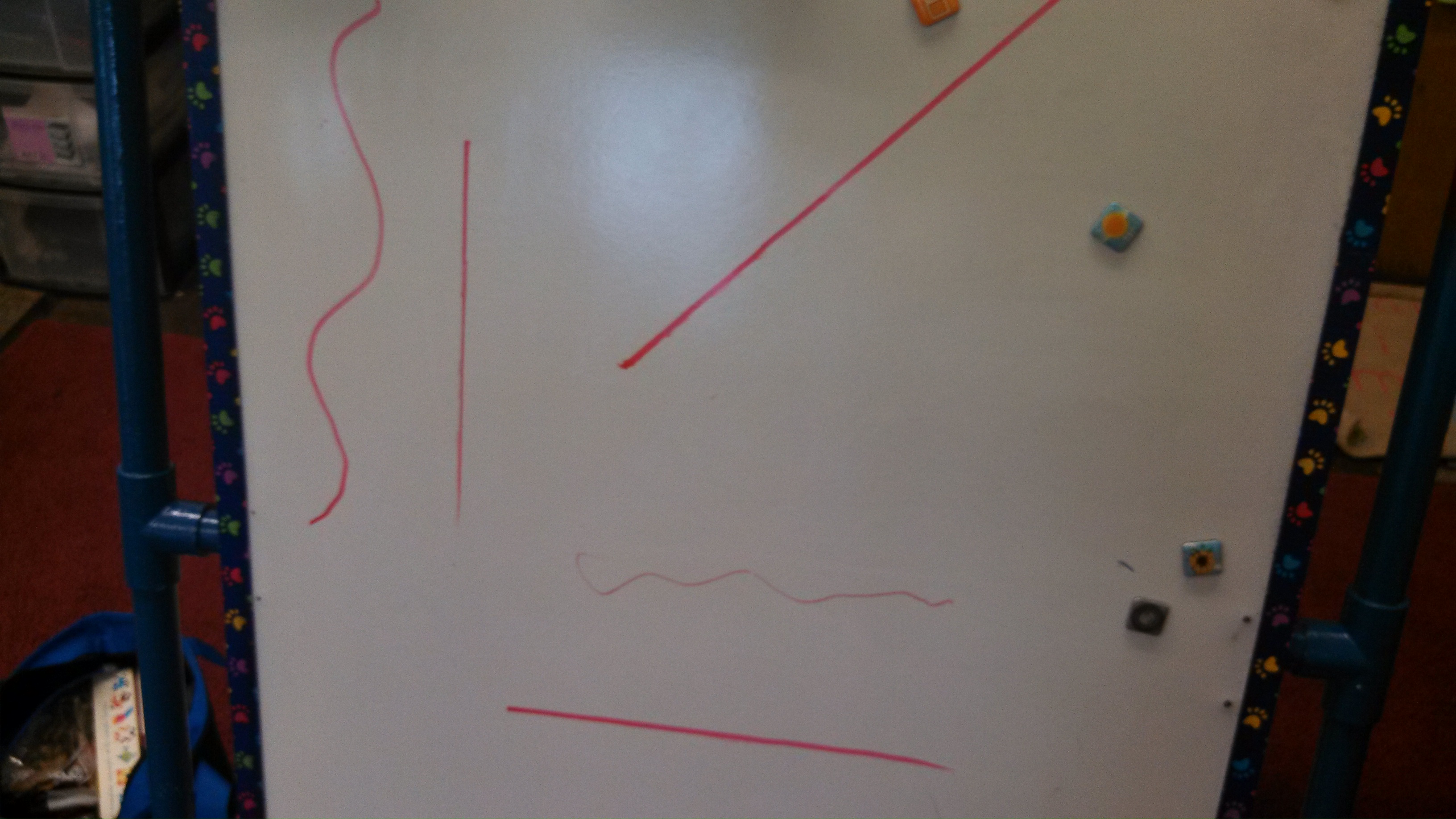
I drew the straight, horizontal line, and asked if it was a straight line. All hands went up, even Abby’s. I looked at her and said, “Tell me what you’re thinking now.”
“I’m thinking that, even if it’s lying down, it’s still a straight line.”
Interesting.
I drew the diagonal line. Now about half the hands went up. I called on a student who said it wasn’t a straight line:
“Well, it’s almost a straight line, but it’s slanted.” Lots of nods at this.
Nate said, “I don’t think it matters if it’s slanted. Straight means it’s not curved. That line is straight.”
Emma said, “No, straight means it goes like this.” She gestured up and down.
There were lots of furrowed brows.
I drew the squiggly lines and asked who thought they were straight. A few hands went up. Abby raised her hand halfway, then put it down. She said, “I made up a new word for that kind of line. It’s vertiwiggly.”
The class laughed. I smiled and capped my marker. Time was up.
The teacher wants me to come back Monday and pick this up again. So, where should I go from here?
Whatever I do, I’m in no rush to define this loveliness away.

Loved this! I can hear your every word!
Sent from my iPad
>
Thanks, Deb! Where would you go next?
I wonder if the next place to go is examples/non-examples. Give them a bunch of line-like things (straight, curved, wiggly, different orientations and have them sort them into lines/not lines and then write a definition for line and tell what makes the non-lines not lines.
Thanks for the suggestion!
Rotating the whole configuration of WODB shapes on its side was such a surprise! I gasped. In that configuration the gray shape echoes the shape of the border, whereas before the shape of the border didn’t even seem to exist.
Where to do next? I can’t help wonder what they students would come up with if you asked them how to communicate how much a certain line slanted.
Love this post.
I need t put this on post-it note and carry it around with me “I have come to understand that talking about this difference is more important than defining it away.”
I’d never worked with a printed WODB before, and I found that ability to rotate really great!
I love your question: how could they communicate how much a certain line slanted. I wonder what they would come up with?
Such a lovely lesson, Tracy!
I guess one way to begin would be to recall this last conversation. ‘Do you remember what we talked about… some people said… [draw picture] and other people said…[draw picture]’ etc. Like this time, you wouldn’t want to go for closure – just to celebrate and landmark the thinking and talk. (There could be something to put up on the wall?) Maybe some people will have had further thoughts, though of course there’s no need to elaborate or overlay too much on what went before.
I think the students would appreciate another WODB, and I wonder what new thing could be asked of them… Perhaps to talk about a new one and annotate it in small groups, and then to come back together and pool ideas. It could be another geometric one to continue the theme maybe?
Thanks, Simon! We played with more WODBs this Monday and they were a hit.
I love what you said here: “You wouldn’t want to go for closure – just to celebrate and landmark the thinking and talk.”
I spend so much of my time with secondary content, I don’t think about how the basic concepts develop in primary school. Thanks for the insights!
Thank you for reading it! I wonder how your secondary students define straight?
I love this post. It’s one of my favorites. You are wonderful.
Sent from my iPhone
>
Not that you’re biased or anything. 😉
This is fantastic – Thanks for detailing the conversation so specifically, it helps me picture it. I was thinking about giving students cards to move and sort into groups (straight, wiggly, vertical, slanted/diagonal etc.) to organize their thinking before restarting the conversation. Perhaps continue as well on the letter discussion of what parts make up a shape/letter with multiple lines? (For example, I see a U as one line/stroke, but a student mentioned 2 lines and a curve). What makes a letter have 2/3 parts instead of 1? I also thought about writing letters “using only straight lines” – what does the U look like now? Can it still look the same?
I loved that detail about the U. I think of it is being created with one stroke too, but he clearly saw three parts.
What if you had the lines and curves (wigglies) cut out on colored paper and students sorted them as Jo suggested. After the sort, simply re-orient the direction while keeping the sort the same. Ask if they would now change the way they sorted. Hopefully trying to isolate the idea that orientation doesn’t change the definition of straight or curved.
Interesting. I might try this!
Love this! Their is such delight and joy here. Thanks for another post where we can see that it’s not only okay but it’s vital that we open up these conversations so that we can understand the world through our children’s eyes. How else would we learn that straight can have the meanings they give it if we only consider our own perspectives. It seems like being able to say things out loud already starts to complicate things for the kids, so I would say that more talk about whether things change as you orient them differently. I was wondering if kids would say if you described something as wiggly, do you also need the word straight to describe it? Kind of like, does one supersede the other? elham
Thank you! You’re the person who first taught me to try to understand the mathematical world through children’s eyes. I’m still trying to get better at it. 🙂
What a great post! Thank you for those impressions.
I am studying math and will become a math teacher soon. The idea of teaching the students in a way that solutions are not given is a good kind of teaching. It reminds me to the method of research-based learning. I recognized that many times only a few students were participating in the discussion with lot of motivation and curiosity. What about the other students? Maybe it´s a problem, that the other students aren´t enough involved and are excluded from the learning process?
So wouldn´t it be better to practice this learning method in small groups where everybody is forced to represent their own opinions?
Best regards, Moni
Hi Moni, Thanks for your comment and welcome to this amazing profession! In this case, we actually were in a small group, which is why you only hear a few names. More generally, teachers need strategies to make sure everyone is heard and everyone can access the discussion and mathematics. I’d highly recommend two books: Classroom Discussions by Chapin, O’Connor, and Anderson, and Intentional Talk by Kazemi and Hintz. They’re fantastic. Enjoy!
Hi Tracy, many thanks for your fast and detailed reply! You are rigth – there is a need of good strategies, so everybody is included. I really appreciate the book tips you gave me! Thank you for that! I am excited and I am pleased about reading them soon. The books are definitely a good supplement for my studies!
It’s a good idea to work out the solution together with the students. This method is a very good approach to motivate them to perform self paced thinking. However I was also facing the challenge, that some of the students had problems following this approach. I would advise you there to start the class with a session where you explain terms and clarify open questions. With this way you can make sure, that everybody is on the same page. What do you think about that? Do you think it makes sense to explain first the terms or do you think everybody should work without this explanation?
So interesting. Thanks for your comment. I think teachers are often tempted to front-load vocabulary for the reasons you just described, but I’ve found it doesn’t work. We use words to communicate ideas. If we try to introduce the words to kids before they try to communicate about the ideas, the words bounce off. They kids don’t yet feel a NEED for a way to talk about these ideas. Part of why I love Which One Doesn’t Belong is it is a beautiful context to create ambiguity and discussion. It creates the need.
There are some great references on this. If you want the research basis, the best source I know is the literature summary, pages 17 – 25, in Dan Meyer’s dissertation: http://blog.mrmeyer.com/wp-content/uploads/meyer-dissertation-1506-repack.pdf
He also gave a tight 5-minute Ignite! talk about this idea: https://www.youtube.com/watch?v=PIHQH005dJ4
Harel has been one of the giants on the idea of developing the need before you give the solution. Here’s a good summary: http://math.ucsd.edu/~jrabin/publications/ProblemFreeActivity.pdf
Circling back to WODB, I think that introducing a bunch of vocabulary at the beginning of the discussion would backfire. If kids are worried about using the “right” words to talk about their ideas, they talk less. What I’m trying to do with this structure is learn what kids think about shapes. They have plenty of everyday words they can use to talk about their ideas. When we get to a place in the conversation where a precise word helps them out, I’m happy to introduce it, like I did with vertical and horizontal in this conversation. But I want to introduce that word in a way that encourages further discourse, rather than squashes it. In my experience, a rush to formal language can stop kids from talking, which is the last thing I wanted here.
If you’re interested in this idea, I’d suggest you head over to Dan’s blog and search for “aspirin headache.” He wrote a whole series of posts about creating the headache before we give the kids aspirin, rather than handing out aspirin at the beginning of class before anybody has any kind of headaches. You can start here: http://blog.mrmeyer.com/2015/if-math-is-the-aspirin-then-how-do-you-create-the-headache/ It’s a brilliant analogy and has made a big impact on my teaching. Furthermore, Christopher Danielson (the brains behind WODB) wrote quite a bit about all these issues in the teacher’s guide to his book, which will be out this summer. He’s helped me understand just how valuable ambiguity is to teachers. I’m no longer in any rush to clarify, simplify, clear up, settle, define. The ambiguity is often the context for my best thinking, teaching, and learning.
Thank you so much for your remarks and the valuable links. Your approach sounds quite interesting. I’ll take some time to have a look at the provided sources. I’m sure I will be able to use some of the suggested ideas during my classes.
Best regards
2 thoughts:
(1) one other great way to catalyze the “headache” that Tracy talks about in one of her comments is having the kids partner up, one describes a shape or diagram that only they can see, the other tries to draw what they are told, but doesn’t show their work-in-progress with the describer. To make it clear, here’s a Fawn Nguyen post that includes this activity.
(2) I’m now adding the “math teacher” definition of straight-line to my list of unintentional half-truths that we tell students. This one is a little complex, so probably most students will never learn the variety of full, technical definitions of a straight line. Here’s one version in a metric space. I’m not totally sure, but have the feeling that all of the (visually) wiggly lines in this post could actually be straight (under suitably defined metric for the plane).
Vector spaces have another definition. Fun exercise: will the two notions be the same in a normed vector space?
A crazy exercise (or fun game for the teacher to play at home) would be to use the students’ (apparent) misconception and explore the following:
– what properties do we want a [straight line] to have? For example, shortest distance between two points.
– what if we assumed that these [lines are straight] and these other [lines] are not? This means we are magically giving the property we just agreed to these examples and saying these other ones don’t have that property.
What else would be true in our mathematical system? Do we get any results that can’t work together (a contradiction)? If not, what other cool things can we discover about the new world we have just created? What’s the same/different compared with our “usual” world?
It just happens that this particular exploration playing with the definition of “straight line” is really rich and includes: non-euclidean geometry, differential geometry, general relativity.
Thanks so much, Joshua. My husband’s first response when I told him this story? “Is there a mathematical definition of straight?” We looked at each other, blinking for a minute. My first thought was Margaret Wertheim’s lovely TED talk where she gets into what it means to have a straight line on a curved surface.
https://www.ted.com/talks/margaret_wertheim_crochets_the_coral_reef?language=en
There are so many rich conversations to be had here!
Wonderful….the essence of learning….sounds like a fragrance,huh?
Hi! I know this is kind off off topic but I was wondeing which blo platform are you
using for this website? I’m getting sick and tired of WordPress because I’ve
had issues wigh hackers and I’m looking att alternatives for another platform.
I wpuld bbe great if you could point me in the direction of a good platform.